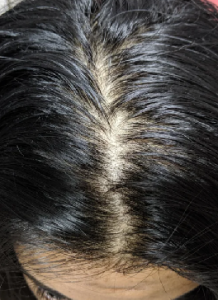An FUE (Follicular Unit Excision) is a surgical procedure and as such it should always be looked at it that way. Fortunately, when I initially described and published this technique in 2002, I called it a ‘minimally invasive hair transplant’ because it did not take on the risks of the then standard Strip Surgery (FUT) that was used until that time as the Standard of Care for Hair Transplants. Both techniques focused upon removing the basic elements of the hair organ system, the follicular unit that contains from 1-4 hairs each.

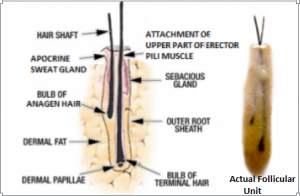
If it was taken by a strip procedure, then microscopic dissection would identify the individual follicular groups (grafts) of 1-4 hairs from the strip under stereo-microscopic. The fibrous attachments shown in the diagram are cut freeing up the graft from the surrounding tissue.
As this FUT surgery required removing a strip of skin, stitches had to be put into the wound to hold it together. Healing for this technique took up to 3 weeks for full strength in the surgical donor wound and some people find the wound painful (about 20-30% of patient need pain medications to offset pain).
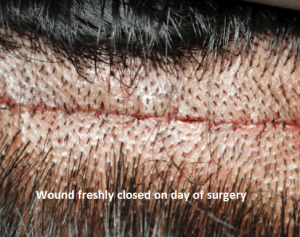

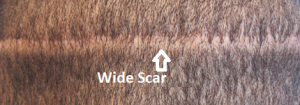
For the FUE, each follicular unit containing 1-4 hairs were cored out with a very small punch and then plucked out of the donor area leaving very small holes that heal within 5 days.
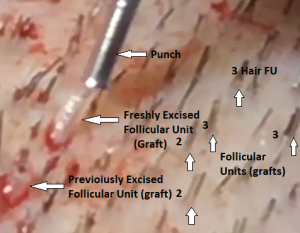
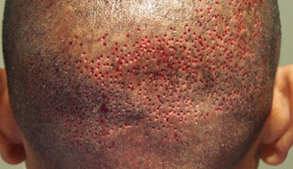
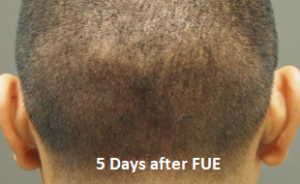
As there was no large wound in the FUE, only small open wounds. Since the FUE wounds close within a few days, there is rarely pain in the donor area, certainly no pulling pain as with the strip surgery. When the surgeon is taking out the graft, if he is not skilled in the technique, he may leave behind the graft buried in the donor area. This can cause infections, abscesses and considerable pain.
As small punches are used with FUE, sometime tiny nerve endings in the skin are cut. If the surgeon is skilled, it is highly unlikely that the surgeon will cut a major nerve in the scalp (because it is deeper than the hair grafts) but it does happen when less skilled surgeons push the punch too deeply into the donor area. When this happens, pain can be prolonged and numbness of the scalp can occur that can last years.
As with any surgical procedure, infection is a risk, but in the thousands of FUE patients we have done, we have never seen an infection nor a buried graft, yet infections and buried grafts have been reported by patients and doctors from around the world. Infections of the FUE wounds most often reflect a less that pristine clean environment and a lack of respect for the use of sterile and disposable equipment, a sterile environment, the use of sterile water, the use of gloves and the use of masks to prevent ‘spitting’ into the wounds when the surgeon or the staff are speaking during the surgery (very common and possibly the most common cause of infections).
When the FUE is not planned out carefully, there is risks of scarring that can exceed the scarring seen in the strip surgery. If too many FUE grafts are taken, then the donor area starts to become balder and balder. Many young men want FUE because they want short hair cuts, but it you look at the photos below, do you honestly believe that these men can cut their hair short? So the risks of FUE become more evident the more FUE grafts that are moved around. For this reason, make sure that you understand what happens as the FUE grafts exceed 3000 and go to 4000 or 5000 or 6000 grafts. What happens is progressive evident hair loss in the donor area in the back of the head and these photos show it clearly!
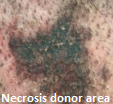
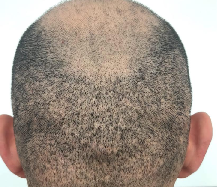
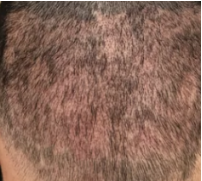
Additional risks include : (1) Necrosis of the donor area (shown in photo) which means that the surgeon cut off the blood supply to the area that was harvested, (2) over-harvested donor areas which means that there is not enough hair to cover the FUE scars, even in the hair is grown-out longer as shown in the last picture. A good, well-experienced surgeon knows where the limits of FUE are and when over-harvesting becomes a real risk, and (3) the risk of failure of the grafts to grow. FUE is unique in that the grafts are not protected from the environment when they are removed so great care is required to protect the grafts from drying. Damage from handling during the actual excision part of the surgery as the grafts are taken out can kill-off grafts. If the grafts are left exposed to the air for about 20 seconds, they may die, yet they can be put back into the recipient area while the doctor has no idea that the grafts are already dead. These dead grafts will not grow. (4) poor use of instrumentation may cause the grafts to be stripped of the fat that surrounds the grafts, damaging the growth centers of each hair causing a failure of those hairs to grow. (5) kinking of the grafts also negatively impacts graft growth, (6) Last but not least reflects the time the grafts are out of the body, as it must be under 8 hours, preferably much less. The longer the grafts are out of the scalp, the higher the risk of long-term damage so the speed and efficiency of the surgical team is critically important and you will want find a surgeon and team with a great deal of experience.
The FUE surgery requires a strict quality control process to guarantee the survival of the grafts. This is not the place for amateurs. Beware of unlicensed technicians now offering FUE under specific doctor’s offices where the doctor doesn’t understand the process or have any training in hair transplantation. Free-lancing groups of hair transplant technicians make deals with doctors to supply them with patients in return for money. Imagine a family doctor approached by such a team of marketing technicians and offering him $2000 for just the use of one examining room and patient referrals. That is $2000/day that he/she would have never seen without his/her participation in this scam. This is an illegal process in most states, even California came out with a firm statement about the process. We have seen one patient who died at the hands of an ignorant doctor using a team of technicians incapable or recognizing that the patient was dying on the operating room table. This man was under 40 and had two children, very sad.
Message: Get a doctor with an experienced team when considering any type of hair transplant. Check out (1) the doctor’s reviews on Yelp, Realself, the internet, (2) ask to meet his/her patients one-on-one so you can ask about the experience and see the quality of the hair transplant yourself and ask yourself the most important question: Would I be happy with what the patient is showing me?












